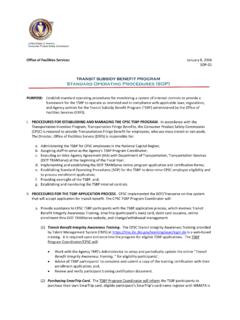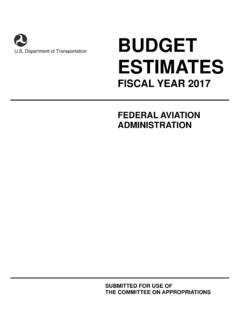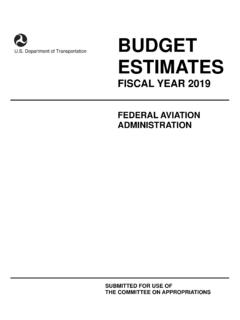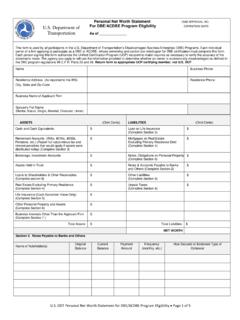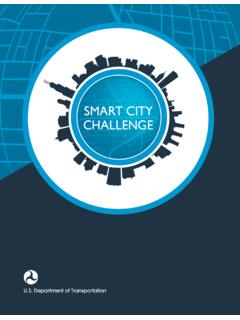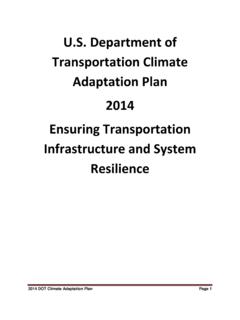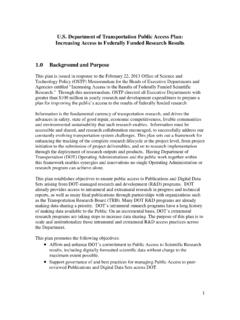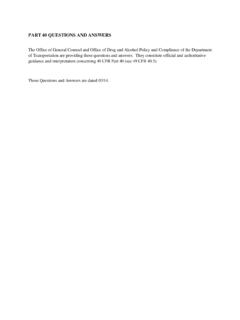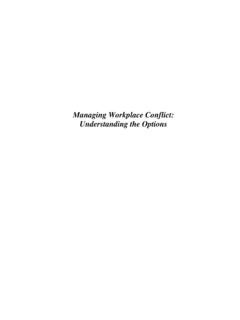Transcription of FY 2017 NHTSA CBJ FINAL 02 03 2016 - US …
1 BUDGETESTIMATES FISCAL YEAR 2017 _____ NATIONAL HIGHWAY TRAFFIC SAFETY ADMINISTRATION _____ SUBMITTED TO THE COMMITTEES ON APPROPRIATIONSi This Page Left Intentionally Blank This age Left Intentionally Blank ii Table of Contents STATEMENT OF THE ADMINISTRATOR .. v Overview .. 1 FY 2016 Requested FTE .. 7 FY 2017 Requested FTE .. 8 Section 2: Budget Summary Tables .. 10 Comparative Statement of New Budget Authority (Exhibit II-1) .. 10 Budgetary Resources by Appropriation (Exhibit II-2) .. 11 Budgetary Resources by Strategic Goals (Exhibit II-3 and II-3a) .. 12 Budget Authority (Exhibit II-4) .. 13 Budget Outlays (Exhibit II-5) .. 15 Analysis of Change Table (Appropriations, Obligation Limitation, and Exempt Obligations (Exhibit II-6).)
2 16 Full-time Equivalent Employment (FTE) (Exhibit II-8) .. 22 Full-time Permanent Position (FTP) (Exhibit II-9) .. 23 Section 3: Budget Request by Account .. 24 Explanation of Major Initiatives .. 24 Explanation of Major Funding for FY 2017 .. 25 Justification for Additional 28 Appropriation Language Vehicle Safety .. 34 Appropriation Language Highway Safety .. 35 Appropriation Language Grants .. 36 Vehicle Safety Program and Financing Schedule .. 38 Vehicle Safety Object Class Schedule .. 39 Vehicle Safety Summary by Program Activity (Exhibit III-1 and 1a) .. 40 Veicle Safety Program and Performance Statement .. 42 Highway Safety Program and Financing Schedule .. 94 Highway Safety Object Class Schedule .. 95 Highway Safety Research and Development Summary by Program Activity (Exhibit III-1 and III-1a).
3 96 Highway Safety Research and Development Program and Performance Statement .. 98 Highway Traffic Safety Grants Program and Financing Schedule .. 168 iii Highway Traffic Safety Grants Object Class Schedule .. 169 Highway Traffic Safety Grants Summary by Program Activity Table (Exhibit III-1 and III-1a) .. 170 Highway Traffic Safety Grants Program and Performance Statement .. 172 21st Century Clean Transportation Plan Investments .. 202 Ten-Year Appropriation 206 Section 4: Research, Development and 212 RD&T Request (Summary) (Exhibit IV-I) .. 212 Attachments .. 214 NHTSA Hiring Priorities FTEs & FTPs .. 214 Congressional Reporting/Follow-Up to Action Plans .. 215 iv This Page Left Intentionally Blank v STATEMENT OF THE ADMINISTRATOR Safety continues to be the top priority for the Department of Transportation (DOT), for the National Highway Traffic Safety Administration ( NHTSA ), and for the people we serve.
4 Over the past decade, NHTSA s dedicated staff worked with our many partners to reduce traffic fatalities by nearly 25 percent. During my tenure, we have worked to strengthen what works, fix what doesn t, and ensure that we re using every tool at our disposal to achieve our mission. Despite decades of steady progress, we still have much work ahead of us. In 2014, 32,675 Americans died on our roadways and over million people were injured. That s a mind-boggling 90 deaths every day and more than 260 people injured every hour. Those deaths and injuries were preventable. Those Americans and their families deserve our best efforts to prevent additional deaths and injuries.
5 Regrettably, the statistics for the first half of 2015 reflect an increase of fatalities. This highlights the need for the continued important work performed by NHTSA . NHTSA s Fiscal Year 2017 budget request supports the Agency s full spectrum of vehicle and behavioral safety areas. Vehicles on our Nation s roadways are the safest in the world, and we remain dedicated to making them safer every day, and to identifying and removing unsafe vehicles from the road. Continuing advances in automotive technology and vehicle innovation have created new possibilities and offer enormous safety potential. But the data reminds us that three persistent facts remain in traffic safety Fifty percent of passenger vehicle occupants killed in crashes are unbelted; Thirty percent of highway fatalities involve an impaired driver; and More than ninety percent of crashes involve an element of human error.
6 This is why NHTSA will continue to strengthen core safety programs. The Agency has well-established and successful campaigns with household names, such as Click It or Ticket, Drive vi Sober or Get Pulled Over, and more recently, U Text. U Drive. U Pay. These campaigns are changing attitudes, changing how Americans drive for the better, and saving lives. Safety is a shared responsibility. Federal and State governments, community leaders, automobile and parts manufacturers, researchers, families and individuals all play a vital role in reducing fatalities and injuries on our roadways. The Agency provides grants to states and local governments that are vital to the success of our behavioral and data programs.
7 These partnerships are to enforce laws against drunk and distracted driving, to provide technical assistance on graduated licensing and other safety issues, and to support a wide range of activities that save lives. Our FY 2017 Budget Request is a key step in pursuit of our goals. The request totals $1,181 billion and includes $250 million for Vehicle Safety, $ million for Behavioral Safety, $ million for State Grants and High Visibility Enforcement Support and $200 million for Autonomous Vehicle Development as part of the 21st Century Transportation Plan Investments initiatives. This budget is designed to increase safety across all modes of surface transportation, keep our economy moving forward and enhance our efforts to ensure automakers quickly find and fix safety defects.
8 And while we can never put a price on a life lost, this budget seeks to address the fact that, in 2010 alone, motor vehicle crashes imposed $836 billion in economic cost and societal harm on our Nation and citizens. Our FY 2017 includes significant increases from the FY 2016 request for further improvements to our vehicle defect programs, our behavioral research efforts, and our work to modernize our data systems. This request also includes an increase from the FY 2016 enacted funding level for many of our other programs. These increases will help ensure that NHTSA has the people and funding it needs to carry out our mission, and that we can make the best possible use of the resources available by investing in innovation.
9 My vision as we move into FY 2017 is to develop a more robust and proactive defects recall program, expand on the success we have had to influence behavior via our media campaigns, and continue our research on safety initiatives. This budget provides us the resources to move forward on the safety programs to provide safer drivers, safer cars, and safer roads. Over the last year, I have heard from our many partners, and we ve made headway in identifying new ways to approach highway and vehicle safety. The Fiscal Year 2017 budget request will support our efforts and collaborate with all of our partners to achieve the greatest reduction in roadway crashes, injuries and fatalities in the most effective way possible with the budget that we have requested.
10 Mark R. Rosekind, PhD vii This Page Left Intentionally Blank 1 National Highway Traffic Safety Administration FY 2017 Budget Request Overview Overview In 2014 the Nation lost 32,675 people in crashes on roadways. Additionally, the preliminary information for the first six months in 2015 reflects an increasing trend in fatalities. In the midst of this data, we are continuing to see a prolific increase of technology and working to ensure these technologies add to the safety of the public. During 2014, we witnessed the largest vehicle recalls in the agency s history. These two overarching events have impacted the attitude and awareness of American drivers.
